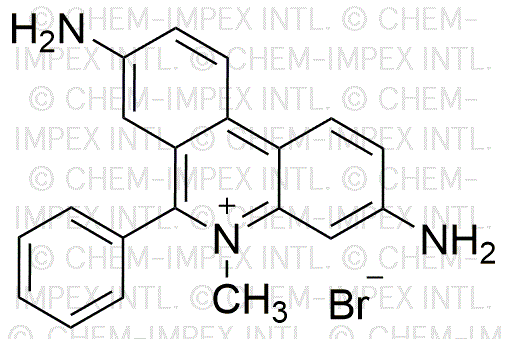Dimidium bromide is widely utilized in research focused on:
- Antimicrobial Research: This compound is effective against various bacteria and fungi, making it valuable in developing new antimicrobial agents.
- Cellular Imaging: Its fluorescent properties allow researchers to use it as a staining agent in microscopy, helping visualize cellular structures and processes.
- Environmental Monitoring: Dimidium bromide is used in assessing the presence of pollutants in water samples, aiding in environmental protection efforts.
- Pharmaceutical Development: It plays a role in drug formulation, particularly in creating compounds that target specific biological pathways.
- Biological Research: The compound is utilized in studies related to cell viability and apoptosis, providing insights into cancer research and treatment strategies.
General Information
Properties
Safety and Regulations
Applications
Dimidium bromide is widely utilized in research focused on:
- Antimicrobial Research: This compound is effective against various bacteria and fungi, making it valuable in developing new antimicrobial agents.
- Cellular Imaging: Its fluorescent properties allow researchers to use it as a staining agent in microscopy, helping visualize cellular structures and processes.
- Environmental Monitoring: Dimidium bromide is used in assessing the presence of pollutants in water samples, aiding in environmental protection efforts.
- Pharmaceutical Development: It plays a role in drug formulation, particularly in creating compounds that target specific biological pathways.
- Biological Research: The compound is utilized in studies related to cell viability and apoptosis, providing insights into cancer research and treatment strategies.
Documents
Safety Data Sheets (SDS)
The SDS provides comprehensive safety information on handling, storage, and disposal of the product.
Product Specification (PS)
The PS provides a comprehensive breakdown of the product’s properties, including chemical composition, physical state, purity, and storage requirements. It also details acceptable quality ranges and the product's intended applications.
Certificates of Analysis (COA)
Search for Certificates of Analysis (COA) by entering the products Lot Number. Lot and Batch Numbers can be found on a product’s label following the words ‘Lot’ or ‘Batch’.
*Catalog Number
*Lot Number
Certificates Of Origin (COO)
This COO confirms the country where the product was manufactured, and also details the materials and components used in it and whether it is derived from natural, synthetic, or other specific sources. This certificate may be required for customs, trade, and regulatory compliance.
*Catalog Number
*Lot Number
Safety Data Sheets (SDS)
The SDS provides comprehensive safety information on handling, storage, and disposal of the product.
DownloadProduct Specification (PS)
The PS provides a comprehensive breakdown of the product’s properties, including chemical composition, physical state, purity, and storage requirements. It also details acceptable quality ranges and the product's intended applications.
DownloadCertificates of Analysis (COA)
Search for Certificates of Analysis (COA) by entering the products Lot Number. Lot and Batch Numbers can be found on a product’s label following the words ‘Lot’ or ‘Batch’.
*Catalog Number
*Lot Number
Certificates Of Origin (COO)
This COO confirms the country where the product was manufactured, and also details the materials and components used in it and whether it is derived from natural, synthetic, or other specific sources. This certificate may be required for customs, trade, and regulatory compliance.


